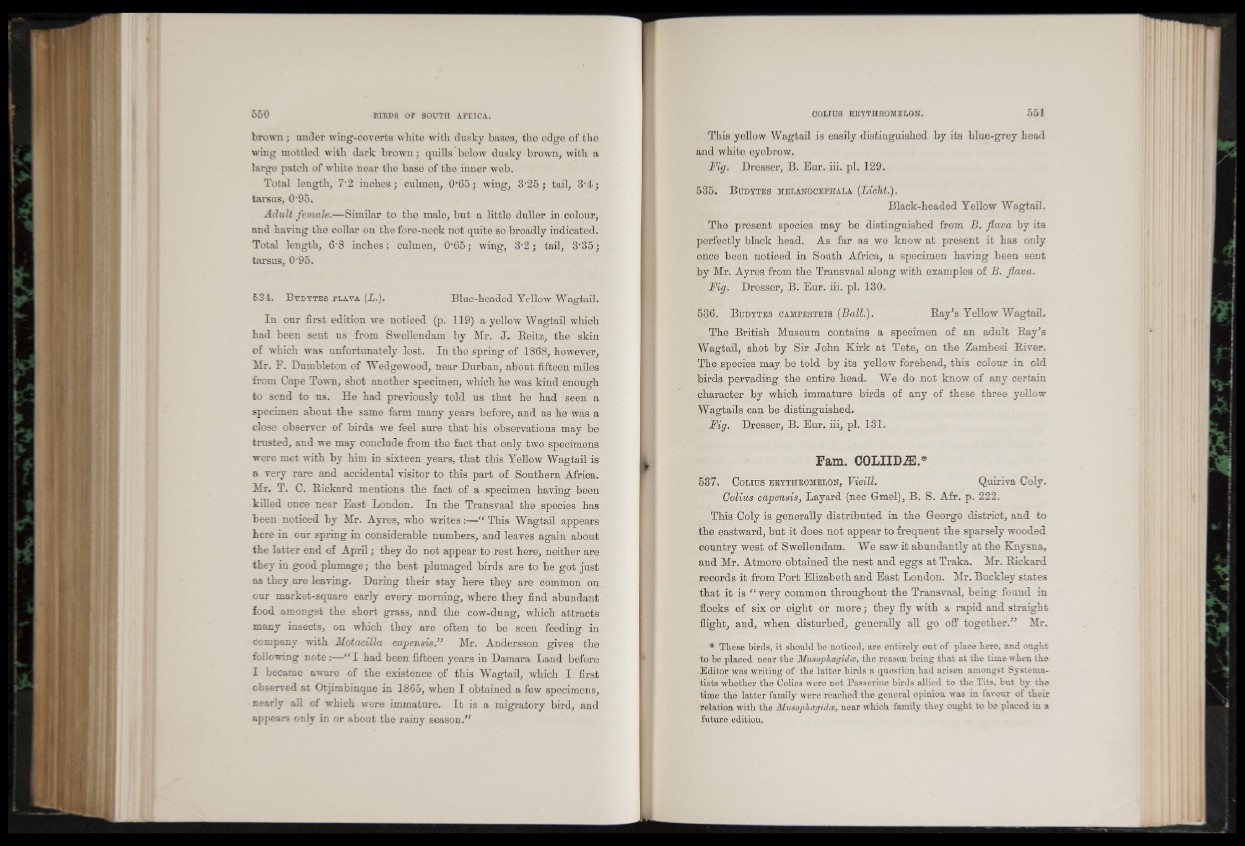
brown 5 under wing-coverts white with dusky bases, the edge of the
wing mottled with dark brown; quills below dusky brown, with a
large patch of white near the base of the inner web.
Total length, 7'2 inches; culmen, 0-65; wing, 3'25 j tail, 3'4<;
tarsus, 0‘95.
Adult female.—Similar to the male, but a little duller in colour,
and having the collar on the fore-neck not quite so broadly indicated.
Total length, 6'S inches; culmen, 0-65; wing, 8-2 ; tail, 3-35;
tarsus, 0‘95.
5 3 4 . B u d t t b s f l a v a ( L . ) . Blue-headed Yellow Wagtail.
In our first edition we noticed (p. 119) a yellow Wagtail which
had been sent us from Swellendam by Mr. J. Reitz, the skin
of which was unfortunately lost. In the spring of 1868, however,
Mr. F. Dumbleton of Wedgewood, near Durban, about fifteen miles
from Cape Town, shot another specimen, which he was kind enough
to send to us. He had previously told us that he had seen a
specimen about the same farm many years before, and as he was a
close observer of birds we feel sure that his observations may be
trusted, and we may conclude from the fact that only two specimens
were met with by him in sixteen years, that this Yellow Wagtail is
a very rare and accidental visitor to this part of Southern Africa.
Mr. T. C. Rickard mentions the fact of a specimen having been
killed once near East London. In the Transvaal the species has
been noticed by Mr. Ayres, who writes:—" This Wagtail appears
here in our spring in considerable numbers, and leaves again about
the latter end of April j they do not appear to rest here, neither are
they in good plumage; the best plumaged birds are to be got just
as they are leaving. During their stay here they are common on
our market-square early every morning, where they find abundant
food amongst the short grass, and the cow-dung, which attracts
many insects, on which they are often to be seen feeding in
company with Motacilla capensis.” Mr. Andersson gives the
following note:—“ I had been fifteen years in Damara Land before
I became aware of the existence of this Wagtail, which I first
observed at Otjimbinque in 1865, when I obtained a few specimens,
nearly all of which were immature. It is a migratory bird, and
appears only in or about the rainy season.”
This yellow Wagtail is easily distinguished by its blue-grey head
and white eyebrow.
Fig. Dresser, B. Eur. iii. pi. 129.
535. B udytbs mblanocepiiala (Licht.).
Black-headed Yellow Wagtail.
The present species may be distinguished from B. flava by its
perfectly black head. As far as we know at present it has only
once been noticed in South Africa, a specimen having been sent
by Mr. Ayres from the Transvaal along with examples of B. flava.
Fig. Dresser, B. Eur. iii. pi. 130.
536. B udytbs campbstris {Ball.). Ray’s Yellow Wagtail.
The British Museum contains a specimen of an adult Ray’s
Wagtail, shot by Sir John Kirk at Tete, on the Zambesi River.
The species may be told by its yellow forehead, this colour in old
birds pervading the entire head. We do not know of any certain
character by which immature birds of any of these three yellow
Wagtails can be distinguished.
Fig. Dresser, B. Eur. iii, pi. 131.
Fam. COLIIDiE.*
537. C olius erythromelon, Vieill. Quiriva Coly.
Colius capensis, Layard (nec Gmel), B. S. Afr. p. 222.
This Coly is generally distributed in the George district, and to
the eastward, but it does not appear to frequent the sparsely wooded
country west of Swellendam. We saw it abundantly at the Knysna,
and Mr. Atmore obtained the nest and eggs at Traka. Mr. Rickard
records it from Port Elizabeth and East London. Mr. Buckley states
that it is “ very common throughout the Transvaal, being found in
flocks of six or eight or more; they fly with a rapid and straight
flight, and, when disturbed, generally all go off together.” Mr.
* These birds, it should be noticed, are entirely out of place here, and ought
to be placed near the Musophagidce, the reason being that at the time when the
Editor was writing of the latter birds a question had arisen amongst Systema-
tists whether the Colies were not Passerine birds allied to the Tits, but by the
time the latter family wero reached the general opinion was in favour of their
relation with the Miisophagidce, near which family they ought to be placed in a
futuro edition.